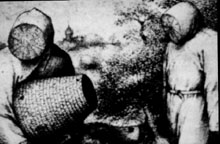Honey Bee Management
- Scheduling Tasks
- Supplemental Feeding
- Inspecting the Hive
- Replacing Queens
- Collecting Surplus Nectar
Scheduling Tasks
 Management is scheduled around natural nectar flows. Beekeepers want their colonies to reach maximum strength before the nectar flows begin. This way, bees store the honey as surplus that the beekeeper can harvest instead of use the honey to complete their spring build-up. Nectar flows are very different between north and south Georgia (Table 1) so plan your beekeeping tasks according to the nectar flows in your area.
Management is scheduled around natural nectar flows. Beekeepers want their colonies to reach maximum strength before the nectar flows begin. This way, bees store the honey as surplus that the beekeeper can harvest instead of use the honey to complete their spring build-up. Nectar flows are very different between north and south Georgia (Table 1) so plan your beekeeping tasks according to the nectar flows in your area.

Table 1. Major pollen and nectar sources of Georgia.
Supplemental Feeding
Feeding should be done January through February. Queens resume laying eggs in January after which brood production accelerates rapidly to provide the spring work force. Some colonies will need supplemental feeding. If colonies are light when you hoist them from the rear, they need sugar syrup. Mix syrup (one part sugar: one part water) and feed the bees heavily. Commercially available pollen supplements provide extra protein for population growth.
Inspecting the Hive
By mid-February, the hives are ready for detailed inspection. On warm days (at least 45 degrees F) check the colonies for population growth, the arrangement of the brood nest, and disease symptoms. Colonies with less brood than average can be strengthened by giving them frames of sealed brood from stronger neighbors. If you use two hive bodies, most of the bees and brood may be in the upper body with little activity in the bottom one. If so, reverse the hive bodies, putting the top one on the bottom. This relieves congestion and discourages swarming. If you use one hive body, relieve congestion by providing honey supers above a queen excluder. Swarming should be avoided because it severely reduces colony strength.
Replacing Queens
Mail-order queens are usually available by the last week in March. Queens should be replaced if their brood production is lower than average. To requeen a colony, first find, kill and discard the old queen. Remove the attendants provided with the new queen, then insert the queen, still in her cage, between two center combs in the brood nest. After 2 days examine the cage. You should see one of two behaviors from the hive bees outside the cage: (1) rejection (Fig. 1) – the bees will be tightly clustered on the cage with many of them biting the wires of the cage or (2) acceptance (Fig. 2)– the bees will be freely walking about the cage. If bees are rejecting the queen, return her in her cage to the center of the brood nest and check again the next day. Persistent rejection behavior indicates that another queen is running free in the colony. It helps acceptance to regularly cut out natural queen cells the workers may be constructing throughout the brood nest. If bees are accepting the queen, you may remove the cork and allow the queen to release herself.
With a new queen, you can also make up a new colony by taking frames of brood, honey and bees from a strong colony (leaving behind the old queen), placing them in a new hive body with a new queen then moving the new hive to a new location. This controlled "splitting" of a colony lets a beekeeper manage the swarming process; congestion and the swarming urge are relieved in the strong colony, and the removed bees are housed in a managed hive instead of lost.

Fig. 1

Fig. 2
Collecting Surplus Nectar
If you feed your colonies and control swarming, they should be strong enough to collect surplus nectar by mid-April. This is the time to add honey supers above the hive bodies (Fig. 3). Add plenty of supers to accommodate incoming nectar and the large bee populations; this stimulates foraging and limits late-season swarming. As nectar comes in, bees place it in cells and evaporate it to about 18 percent water content. When bees cap the honey, it is considered ripe. At harvest time, use commercially available bee repellents to drive bees from the supers.
Not all honeys are alike. Usually, lighter honeys command higher prices, and most beekeepers try to keep darker honeys from mixing with lighter ones. For example, beekeepers in north Georgia remove supers with dark sumac honey before it can mix with incoming sourwood honey which is lighter. Consult Table 1 and local beekeepers to determine the proper time to remove your honey.
During late summer and early autumn, brood production and honey production drop. Unlike in spring, you should now crowd the bees by giving them only one or two honey supers. This forces bees to store honey in the brood nest. Colonies are usually overwintered in two hive bodies or in one hive body and at least one honey super. Colonies should weigh at least 100 pounds in late fall. If they are light on stores, feed them a heavy syrup (two parts sugar : one part water).

Fig. 3
